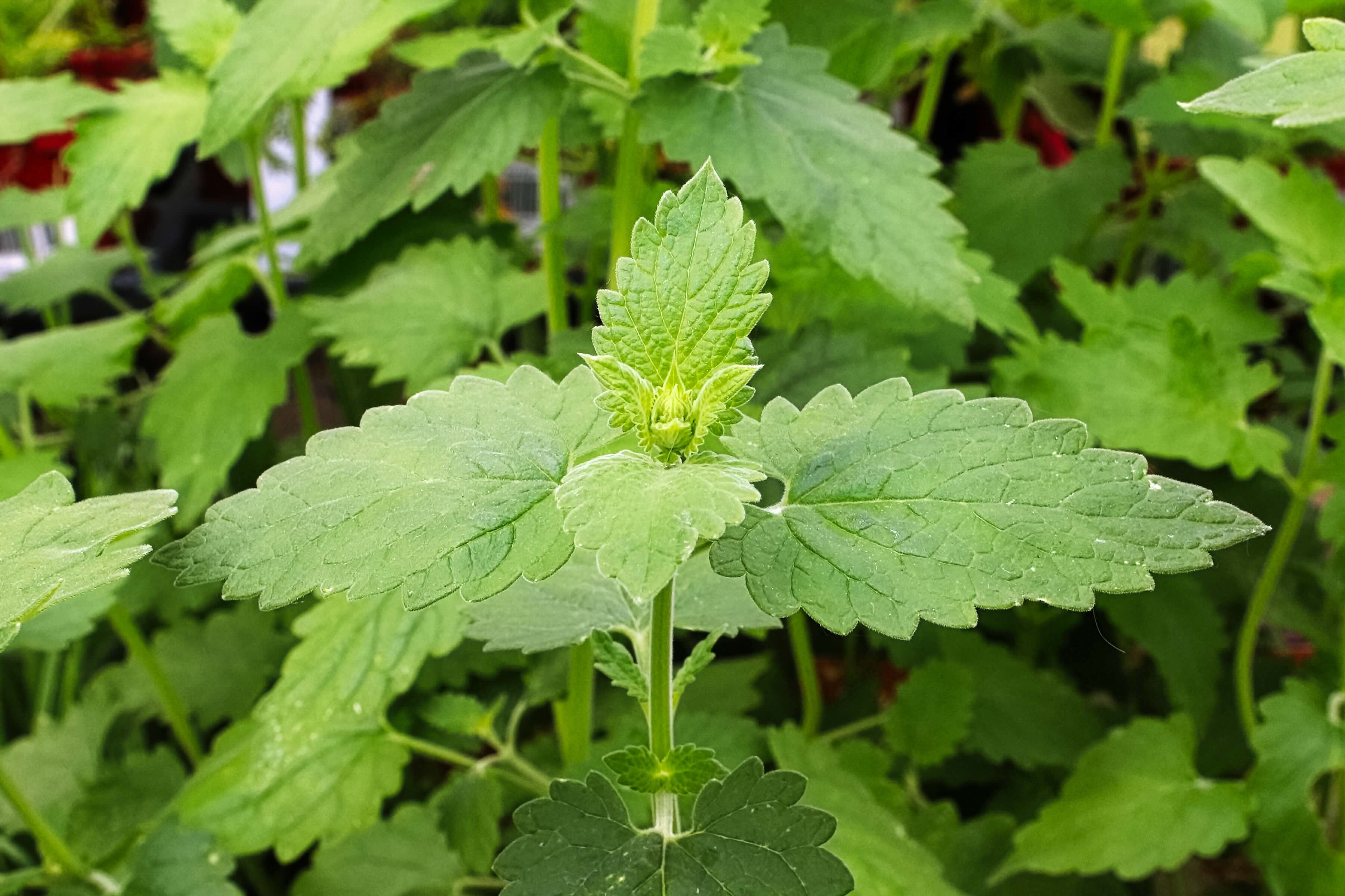Catnip, the magical herb that sends many felines into fits of playful frenzy or blissful relaxation, is a common treat for our beloved cats. But beyond the amusing antics it inspires, many cat owners wonder: Do Cats Eat Catnip, and is it safe for them to do so?
This article dives deep into the world of catnip and cats, exploring not just whether they eat it, but also the science behind its effects, the benefits of ingestion, potential side effects, and how to offer catnip safely to your furry friend. We’ll unravel the purr-plexing questions surrounding this popular herb and equip you with the knowledge to enhance your cat’s happiness and well-being.
What Exactly is Catnip?
Catnip, scientifically known as Nepeta cataria, is an herb belonging to the mint family. Native to Europe and Asia, it’s now easily cultivated in North America and many other parts of the world. This resilient plant is characterized by its light-green foliage and delicate lavender flowers, making it a visually appealing addition to any garden, even beyond its appeal to cats.
Historically, catnip hasn’t just been for feline enjoyment. Its leaves have been brewed into teas for human consumption, and its flowers are believed to possess cough-relieving properties. Interestingly, catnip also finds its way into natural insect repellents, showcasing its versatile nature.
Catnip and Cats: It’s All About the Scent (and Sometimes Taste!)
The magic of catnip lies within an essential oil called nepetalactone, found primarily in the plant’s leaves and stems. When a cat encounters catnip, typically through smell, nepetalactone triggers a fascinating response.
Cats possess a specialized scent organ called the vomeronasal gland, located in the roof of their mouth. This gland acts as a unique pathway, allowing scents inhaled through the nose and mouth to be directly transported to the brain. This explains why you might observe your cat making a funny, open-mouthed face, known as the Flehmen response, when they encounter interesting smells, including catnip. It’s through this vomeronasal organ that nepetalactone exerts its captivating influence on felines.
The Allure of Catnip: Why Cats Are Drawn To It
So, what is it about catnip that makes cats go wild? Nepetalactone, the active compound, mimics feline sex pheromones. This clever mimicry is why cats reacting to catnip often exhibit behaviors reminiscent of a female cat in heat. While this might sound specific to female cats, both male and female cats are susceptible to catnip’s enchanting effects.
 cat smelling dried catnip
cat smelling dried catnip
These behaviors can range from overt displays of affection, like rubbing, rolling, and purring, indicating relaxation and happiness, to more energetic behaviors like heightened playfulness, running around, and even, in some cases, mild aggression. The reaction is highly individualistic, with each cat responding in their unique way to the captivating scent of catnip.
Can Cats Eat Catnip? The Digestible Details
Now, to answer the core question: yes, cats can eat catnip, and it’s generally considered safe for them to ingest in small to moderate amounts. In fact, eating catnip can produce slightly different effects compared to just smelling it. While inhaling catnip primarily leads to the well-known euphoric and playful reactions, ingesting it may have a more calming or sedative effect.
Furthermore, catnip may even offer some digestive benefits for cats. Historically, catnip has been used in humans to alleviate diarrhea, and it’s believed to have similar properties for cats. A small amount of ingested catnip might help soothe mild digestive upset in felines.
Potential Benefits of Eating Catnip
While most of the research and anecdotal evidence focuses on the behavioral effects of smelling catnip, there are potential benefits to consider when cats eat it:
- Digestive Aid: As mentioned, catnip may help settle an upset stomach and alleviate mild diarrhea due to its traditional use as an antidiarrheal.
- Calming Effect: Ingesting catnip might promote relaxation and calmness. This could be helpful for cats who are anxious or stressed, although the scent is typically used for this purpose.
- Natural and Safe: Catnip is a natural herb, and in reasonable quantities, it’s a safe treat for most cats.
It’s important to note that these benefits are not as well-documented as the behavioral effects of smelling catnip, but they are potential advantages of allowing your cat to nibble on the herb.
Potential Side Effects of Eating Too Much Catnip
While catnip is safe in moderation, overconsumption can lead to some temporary digestive issues. If a cat eats a large quantity of catnip, they might experience:
- Vomiting: Excessive catnip can irritate the stomach lining, leading to vomiting.
- Diarrhea: While small amounts might help with diarrhea, large amounts can have the opposite effect and cause loose stools.
- Upset Stomach: General signs of digestive discomfort, like loss of appetite or lethargy, could occur.
- Dizziness or Uncoordination: In rare cases, very high doses might cause temporary dizziness or difficulty walking.
These side effects are usually mild and short-lived, resolving on their own within 24 hours. However, it’s always best to offer catnip in moderation to prevent any digestive upset.
Different Ways to Offer Catnip, Including Eating
Catnip comes in various forms, catering to different preferences and purposes:
- Fresh Catnip: Growing your own catnip plant is a fantastic way to provide fresh, potent catnip. Cats can nibble directly from the plant, and you can also harvest leaves to dry or use fresh.
- Dried Catnip: This is the most common form available in pet stores. Dried catnip can be sprinkled on toys, scratching posts, or the floor for cats to roll in, sniff, and potentially eat.
- Catnip Sprays and Bubbles: These are primarily for scent enrichment and are less likely to be ingested. Sprays are great for refreshing toys or cat furniture, while bubbles offer a playful, scented chase.
- Catnip-Stuffed Toys: Toys filled with dried catnip are a popular and convenient way to provide catnip. Cats will play with the toys, releasing the scent and potentially ingesting small amounts of catnip as they mouth and chew on them.
When offering catnip for consumption, fresh or dried forms are the most direct options. Ensure that any dried catnip you purchase is from a reputable source and free from additives or pesticides.
Catnip Dosage: How Much is Safe to Eat?
Moderation is key when it comes to cats eating catnip. A general guideline is to offer no more than 1 tablespoon of dried catnip at a time. For fresh catnip, a slightly larger amount of leaves is acceptable as it’s less concentrated.
Fresh catnip is generally more potent than dried catnip, so you’ll need to offer less to achieve the desired effect. Highly concentrated catnip oils are best avoided for ingestion due to their potency and potential to cause digestive upset.
If you’re unsure about the right amount for your cat, consulting with your veterinarian is always a good idea. They can provide personalized recommendations based on your cat’s age, size, and health.
Catnip FAQs: Addressing Common Concerns about Ingestion
Let’s address some frequently asked questions about cats eating catnip:
Does eating catnip make cats “high”?
While catnip can induce states of euphoria and intense happiness in cats, it’s not accurate to describe it as making them “high” in the same way that psychoactive drugs affect humans. Cats under the influence of catnip may exhibit playful behavior, drooling, increased vocalization, or hyperactivity, but they typically don’t experience the disorientation, loss of coordination, or dilated pupils associated with true intoxication. Eating catnip might lead to a calmer state compared to the more energized response from smelling it, but it’s still not a “high” in the clinical sense.
Can kittens eat catnip?
Catnip is not harmful to kittens, but most kittens won’t react to catnip until they are around 6 months to 1 year old. This is because the sensitivity to nepetalactone develops as they mature. While they can eat it, it likely won’t have any noticeable effect on them until they reach the appropriate age.
Is catnip addictive for cats?
Catnip is not considered addictive for cats. Cats don’t develop a physical dependence on catnip, and they won’t experience withdrawal symptoms if it’s taken away. While cats may enjoy and seek out catnip, it’s not addictive in the clinical sense of substance addiction.
Conclusion: A Purr-fectly Safe Treat in Moderation
So, do cats eat catnip? Yes, they can, and in moderation, it’s generally safe and can even offer some benefits. While smelling catnip is known for its stimulating and euphoric effects, eating it can be calming and may aid in digestion. However, like any treat, moderation is crucial to prevent potential digestive upset.
By understanding the science behind catnip, its effects on cats, and safe usage guidelines, you can confidently offer this delightful herb to your feline companion and enhance their playtime, relaxation, and overall well-being. Always observe your cat’s individual reaction and adjust the amount of catnip accordingly to ensure a positive and purr-fect experience.

